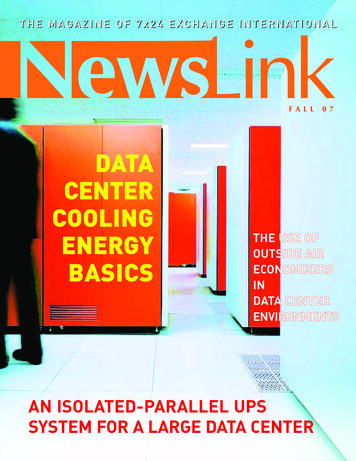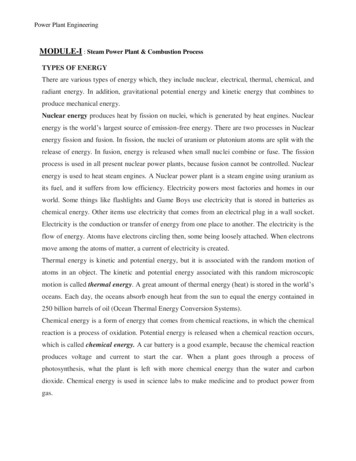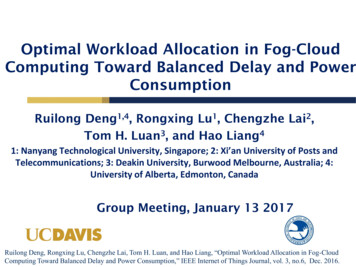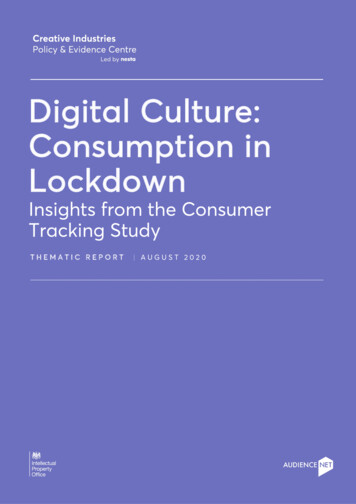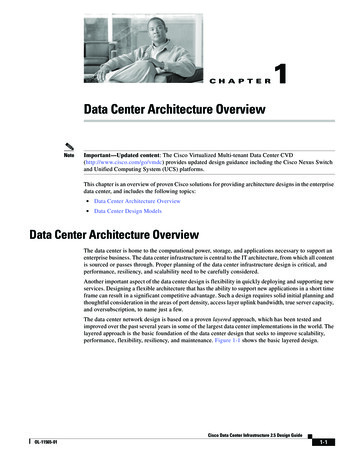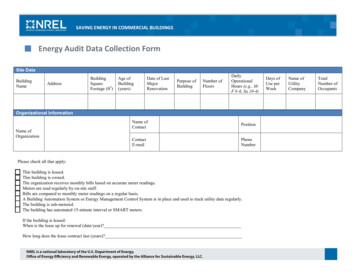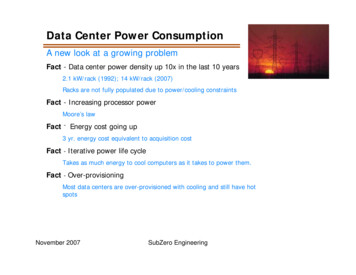
Transcription
Data Center Power ConsumptionA new look at a growing problemFact - Data center power density up 10x in the last 10 years2.1 kW/rack (1992); 14 kW/rack (2007)Racks are not fully populated due to power/cooling constraintsFact - Increasing processor powerMoore’s lawFact - Energy cost going up3 yr. energy cost equivalent to acquisition costFact - Iterative power life cycleTakes as much energy to cool computers as it takes to power them.Fact - Over-provisioningMost data centers are over-provisioned with cooling and still have hotspotsNovember 2007SubZero Engineering
An Industry at the CrossroadsConflict between scaling IT demands and energy efficiencyServer Efficiency is improving year after yearPerformance/Watt doubles every 2 yearsPower Density is Going UpAnnual Growth Rate 4%Application growth Server Performance GrowthData Centers are not ShrinkingInfrastructure Energy Costs Server CostsI&E Costs are over 2X that of 1U Server in 07’I&E Costs significant part of TCOGrowing pressure from both government andcustomers to address climate related issues throughimproved energy efficiencyNovember 2007SubZero Engineering
The greatest gain in reducing kW indata centers is with coolingWhile equipmentmanufactures seek waysto decrease powerconsumption immediateenergy saving can bemade with more efficientcooling strategiesNovember 2007SubZero Engineering
Where is the roadmapto energy savings? Every major manufacture is working on asolution according to their product line––––––New and improved CRAC unitsMonitoring systemsFan powered cabinetsFan powered floorsWater cooled cabinetsReduced power computersNovember 2007SubZero Engineering
Two well know equipment manufacture with ways to lower power consumption inthe data center.Note: the perspective is from their product line not the entire computing envelopeNovember 2007SubZero Engineering
Which cooling solutionshould you try? Few data centers can afford a sweeping replacement orrepositioning of CRAC units Most data centers can’t replace all of their computerracks or relocate racks to hot/cold aisles Impractical to replace all computers with new lessenergy consuming ‘greener’ ones Most of the room cooling solutions are only a piece ofthe whole cooling solutionIs there a tool to help you decide which and when toimplement cooling energy solutions?How can you determine where you will get the mostenergy savings with the least investment?November 2007SubZero Engineering
The Value of Computer Modeling- Computational Fluid Dynamics CFD’s allows for a comprehensive view of the data center coolingarrangement– Both existing and proposed CFD’s see things how they really are– Legacy data centers– Unusual room sizes Difficult Layout’sSmall Subfloor depths – low pressure subfloorBad CRAC unit locationImproper hot/cold aisle separationCFD’s allow you to peer into the future of increased kW– Creeping kW - as new units with larger watts replace older units Try before you buy– See the true effectiveness of proposed solutions– Get the biggest gain per dollar spent Understand the true limits of a proposed data centerNovember 2007SubZero Engineering
Equipment ManufacturesFebruary 16, 2007encourage the use of CFD’sThe Green Grid is a non-profit tradeorganization of IT professionalsformed to address the issues ofpower and cooling in datacentersBy using Computational Fluid Dynamics (CFD) in the datacenterenvironment, the designer can optimize datacenter cool air flowby “tuning” floor tiles by varying locations and by regulating thepercent of vents that are open at any given time or can optimizeCRAC (Computer Room Air Conditioning) unit locations.Some vendors offer cooling optimization services and havedemonstrated over 25% energy savings in real-worldapplications.”“The ability to predict future power and cooling loads is also key inmanaging an energy-efficient datacenter.”“Many datacenters have multiple air conditioners that actually fighteach other. One may actually heat while another cools and one maydehumidify while another humidifies. The result is gross waste thatmay require a professional assessment to diagnose.”November 2007SubZero Engineering
CFD Modeling allows for the input of the bestpractices for a healthy data centerHow much energy and what effect would your data center experience if you 1. Used blanking panels2. Fill cable cut outs3. Eliminate high subfloor air velocity4. Hot aisle/cold aisle5. Matching server airflow6. Eliminate rack gaps7. Use longer rows8. Orient CRAC units perpendicular to hot aisle9. Adding another CRAC unit10. Overhead air conditioning11. Increased subfloor depthNovember 2007SubZero Engineering
Airflowmanagement:Whatis thevalue ofthe science of directing coolAirflowair to the computer thermalEngineering?load and moving hot exhaustair back to the coolingequipment.Computer modelingAirflowallowsthemanagementengineer isrequired because airto examineall ofassumes differentthecharacteristicscooling factorsrelative tofluctuationsin temperatureandsee howtheyand relative humidity (rh).interrelatewith oneUnlike office cooling theanother.unique cooling requirementsin aprovendata centerallow forThismethodcooling only the thermal loadmakesthebestinstead forof thewholeroom.hot and cold air“Most of today’s existing datacenters attempt to coolequipmentby flooding the air supply with as muchseparation.cool air as possible. The cool air produced byCRAC units mixes with the heat produced by theload. This system makes it difficult, if notimpossible,to target 2007specific heat sources within theNovemberdatacenter.”The green gridSubZero Engineering
Basics ofAirflow ManagementRe-circulated airflowBasic areas of concern indata center airflowmanagement include: Airflow to the Intake ofcomputersExhaust airflowfrom other racks Volume Height Exhaust air flow back tothe CRAC unit Bypass airflowBypassairflowThrow ratePerforated TileCable Cut Out Re-circulated airflowSubfloor Air Pressure Balance thermal loadto each CRACNovember 2007SubZero Engineering
Case StudiesFollowing are 5 casestudies demonstratingthe benefits of air flowmanagement in theoverall data centercooling program November 2007SubZero Engineering
Case Study # 1Subfloor PressureThe foundation of every data centercooling solution is the subfloor airplenum.Excessive velocity in the subfloor(caused by high volume airflow fromthe CRAC units) creates ‘rivers’ and‘eddies’ in the subfloor plenum.‘rivers’and‘eddies’causedby highvelocityThe affect of this velocity is seen inthe low flowing areas nearest CRACunits and underneath eddies.lowflowareasNovember 2007SubZero Engineering
Case Study # 1 (continued)SubZero Velocity Adjustorsinstalled underneath the subfloorplenum slow the air speedthereby increasing air pressure.Once the subfloor air pressure isbalanced the perf tiles will allow amore even airflow throughout thedata center.November 2007SubZero Engineering
Case Study # 2Cable cut out coversAir coming from the subfloorplenum through an unmanaged opening (cablecut outs) will negativelyimpact your data centerin two ways1. decreases subfloor airpressure2. confuses CRAC intakesensorsDecreased subfloor air pressurehurts the ‘throw rate’.The CRAC units indicate coolerair and shut down thecooling process affecting rhand leading to demandfighting.November 2007Note the air bypass back to the CRAC without passingthrough the thermal loadNoEngineeringbypass air! Plus a higher more consistent airSubZerotemperature returning to CRAC unit.
Case Study # 3Recirculation of hotexhaust airNovember 2007SubZero Engineering
Case Study # 3Recirculation of hotexhaust airHot exhaust air movesquickly in the data centerdue to higher temperatureand lower rh. This warm aircan easily move back intothe intake (cold) aisle.To correct this we create aCFD to determine themovement and direction ofthis warm air. The next stepis to design a way to directthis movement, including:Hot air evacuation systemsIncreased air flow tilesAisle Isolation systemsNovember 2007Note the hot re-circulated air in the intake (cold)aisle. This is especially prevalent in the upperracks.With increased subfloor airflow along with theefficient removal of hot exhaust air racks can beSubZero Engineering fully populated.
Case Study # 4New ConstructionDesignEven with the advantagesof a three foot subfloorplenum and 30 foot ceilingsCFD’s have proved veryeffective in exposing keydesign flaws.Note the value of the high ceiling still the returnof hot exhaust air to the CRAC required betterseperationCase in point This can be seen by the U shape of the hotexhaust air.November 2007SubZero Engineering
Case Study # 5Disaster RecoveryPlanning- CRAC unit failureThe affect a failed CRACunit will have on yourequipment largelydepends on its location.A CFD can be used todetermine how the failurewill impact operations andcan help create aneffective DR plan.November 2007Failed CRACSubZero Engineering
SubZero EngineeringDelivering a range of energy saving servicesData CenterOn-SiteEngineeredComputer ModelingData GatheringSolutions CFD Rack kW Real world solutions Rack and CRAC data Room layout ROI energy calculator Graphical demonstration Airflow measurements 40 plus page report Rack/room temperature Animated airflow movieNovember 2007SubZero Engineering
Basics of Airflow Management Re-circulated airflow Basic areas of concern in data center airflow management include: Airflow to the Intake of computers Volume Height Exhaust air flow back to Throw rate Bypass Exhaust airflow from other racks Perforated Tile the CRAC unit air



